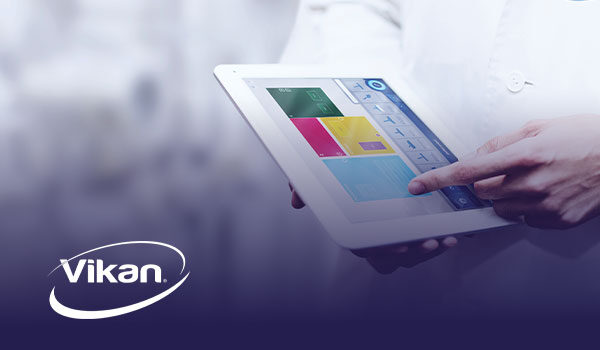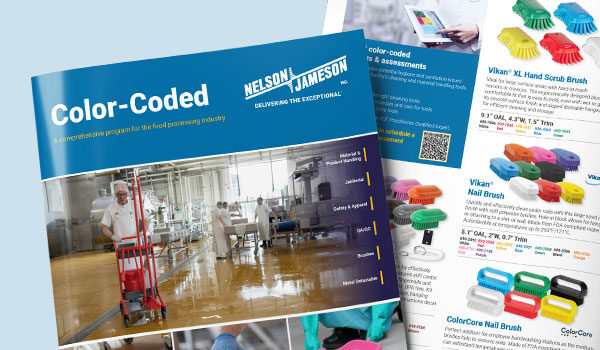
As a part of the Nelson-Jameson product team, I help our organization identify and provide the tools to serve every area of food processing plants. And a major piece of our team’s goal is to find the products that best help food manufacturers’ facilities protect their creations while keeping consumers safe. Among those products that Nelson-Jameson offers is an extensive collection of items for material handling, product handling, janitorial, safety, apparel, QA/QC, metal-detectable applications, and more (find them all at our color-coding buyer’s guide).
But for a food manufacturer, assessing the need for a color-coding system (Nelson-Jameson and Vikan can help with that) and putting the system in place are just the first steps. To truly see benefits like improved efficiency and a better environment for food safety, a robust plan for ongoing monitoring and auditing is the next step.
Any critical system needs regular checks to ensure it's working as intended. Monitoring and auditing allow you to proactively identify any vulnerabilities or areas for improvement. By consistently monitoring how your color-coding system is being used and auditing its effectiveness, you're reinforcing its value and ensuring everyone on your team understands and adheres to the protocols that you’ve built. This helps to maintain clarity, reduces the risk of errors, and ultimately contributes to a safer and more efficient workflow.
"To truly see benefits like improved efficiency and a better environment for food safety, a robust plan for ongoing monitoring and auditing is the next step."
Auditing your color-coding system also helps maximize ROI by reducing your risk of foodborne illness outbreaks, improving efficiency, or reducing waste. And as always, investing in quality tools will extend the lifetime value of the equipment.
Read on below to explore more about why monitoring and auditing are crucial and how to effectively implement them:
As mentioned above, a color-coding system is only as good as its consistent application. Without regular monitoring and auditing, the system can gradually degrade, leading to confusion, inefficiency, and even safety risks. Here are some more specific reasons why these processes are essential:
Identify Deviations: Monitoring helps catch inconsistencies in color usage. Are the correct colors being used for their intended purpose? Are faded or incorrect labels being replaced promptly? Early detection of deviations prevents them from becoming widespread problems.
Measure Effectiveness: Audits allow you to assess if the color-coding system is achieving its goals. Is it reducing downtime? Is communication improving? By tracking key metrics, you can determine the system's impact and make adjustments as needed.
Reinforce Training: Regular monitoring and audits serve as a reminder of the importance of the color-coding system and reinforce the training employees have received. They help maintain awareness and encourage adherence to the established standards.
Improve the System: Feedback gathered during monitoring and audits can be invaluable for identifying areas where the system can be improved. Perhaps certain colors are confusing or not optimized for things like color blindness, or maybe the system needs to be expanded to cover new equipment or processes.
Maintain Compliance: In some industries, color-coding may be tied to regulatory requirements. Regular audits help ensure compliance and avoid potential penalties.
Get the right tools to protect workers and consumers while minimizing the risk of recalls.

Establish Clear Procedures: Define what will be monitored, how often, and who is responsible. Create checklists or standard operating procedures (SOPs) to ensure consistency.
Regular Inspections: Implement routine inspections of equipment, tools, and storage areas to check for correct color usage, label legibility, and overall system integrity.
Employee Feedback: Encourage employees to report any inconsistencies or issues they encounter with the color-coding system. Their on-the-ground experience can provide valuable insights.
Track Key Metrics: Monitor relevant metrics such as downtime, maintenance response times, and safety incident rates to assess the impact of the color-coding system.
Develop an Audit Checklist: Create a comprehensive checklist that covers all aspects of the color-coding system, including color accuracy, label quality, signage, and training records.
Schedule Regular Audits: Determine the appropriate frequency for audits based on the complexity of the system and the criticality of the processes involved.
Document Findings: Keep detailed records of audit findings, including any deviations from the established standards. This documentation is essential for tracking progress and identifying trends.
Take Corrective Action: Develop a plan for addressing any issues identified during the audit. This may involve retraining employees, replacing labels, or updating the color-coding system itself.
Follow-Up: After corrective actions have been taken, follow up to ensure that the issues have been resolved and that the color-coding system is functioning as intended.
By prioritizing monitoring and auditing, you can ensure that your color-coding system remains a valuable tool for improving efficiency, safety, and communication within your manufacturing facility. It's an investment that pays off in the long run by maintaining consistency and maximizing the positive impact of your color-coded environment.
Click here to learn more about how Nelson-Jameson can help you assess your need for a color-coding system and also supply everything you need to color-code your plant. And for more on color coding, check out our complete guide here!

Cassi is a Product Manager - MRO Products at Nelson-Jameson.

September 25, 2025
An innovative lobby dustpan that transforms commercial cleaning. This is not just a basic dustpan; it ha...

September 10, 2025
Food safety is an ongoing commitment. It demands continuous vigilance, collaboration, and access to a we...

August 8, 2025
Innovative sensors can provide solutions and drive progress as evident in the value of in-line turbidity...

Recognize and address possible hygiene and sanitation challenges based on the cleaning and material handling equipment available in your facility.
Through a discovery call, virtual, or on-site assessment, Vikan SQF Practitioner certified specialists will assist in confirming that your system and cleaning tool inventory aligns with your risk management objectives while pinpointing any missing tools and enhancing maintenance and usage practices. Evaluate whether your existing tools are utilized in the most effective manner, or determine if a more suitable tool exists for the task at hand. Ensure that your tools comply with all relevant standards and regulatory requirements. Site evaluations encompass a summary survey, an overview of the location, a color-coded factory layout plan, product suggestions, a recommended order form, and a proposal for a follow-up survey.
Food Safety, Sanitation, Cleaning Tools, Color Coding

This is a comprehensive program for the food processing industry. Nelson-Jameson brings together the most extensive collection of color-coded products for material handling, product handling, janitorial, safety, apparel, QA/QC, and metal-detectable applications. With the right pieces, a color-coding system is a powerful tool in preventing cross-contamination of allergens and food-borne illnesses that can lead to sickness or expensive product recalls.

Food Safety, Sanitation, Cleaning Tools, Color Coding

With existing and emerging threats, food safety has never been more important to food manufacturers in protecting their consumers and their organization.
Color Coding

Laboratory, Color Coding, Food Safety